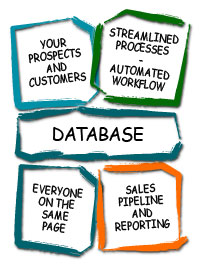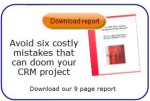Companies that use Sage ACT! can outgrow it. When I lose a client to a solution I don’t support, although I’m sorry to see them go, I know it’s a positive event for their business. Outgrowing the ACT! database means that a company is growing (or has been acquired) and that their processes and requirements have expanded as well.
 This can be a huge challenge to the sales team, who rely on the contact management within ACT! to manage their prospect and customer details. ACT! was designed with them in mind, while the new system is designed to serve the needs of whole operation.
This can be a huge challenge to the sales team, who rely on the contact management within ACT! to manage their prospect and customer details. ACT! was designed with them in mind, while the new system is designed to serve the needs of whole operation.
The primary function of the new solution may be consolidating systems or managing inventory. Because of that the contact management in these systems often feels like an afterthought, and thus is clunky or step-intensive to use. Even if well-designed, the user experience will be very different.
Here are five things you need to know before you make the transition from ACT! to a more complex CRM or ERP system:
- Over time, duplicates can end up in the ACT! database, as well as messy imports or bad data entry. Get a clean start in the new system by cleansing ACT! data before you import into the new system.
- All of your data, including notes, histories, activities, and sales opportunities, should be extracted from ACT! and moved to the new system (An ACT! export just exports field data). Typically all of this historical data can be imported into your new CRM. There are services that can help you extract your ACT! data and prepare it.
- Before users are introduced to the new CRM system, make sure that you:
- Involve your ACT! and new CRM consultants before extracting ACT! data.
- Plan for and allow sufficient time for migration and training.
- Do not expect your salespeople to migrate the data; there are services do that.
- Using sales people to reenter data is an expensive waste of their selling time.
- It does not “teach them how to use the new system.” That’s why they have training.
- It costs the company far more in lost revenue than it saves in data migration costs. Also using sales people like that is devastating to morale.
- Develop the least disruptive transition for your sales people. Appoint a champion for the new system among your sales reps and enlist their help in creating a change management plan. This helps to:
- Minimize disruption.
- Keep people productive.
- Improve user buy-in.
And here’s the final thing: You may not need to retire ACT! at all. Your organization can continue to use ACT! as a contact management “front end” that’s integrated with their new (or existing) systems. This approach eliminates data migration costs, re-training for salespeople, disruption or lost selling time for sales reps – all while eliminating redundant entry or data inconsistencies. While this doesn’t work for every business process, it’s definitely worth a look.
Follow best practices and avoid 6 mistakes that can doom your CRM project. Download our free report!
Related articles




